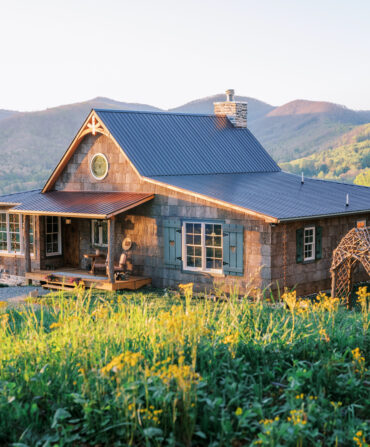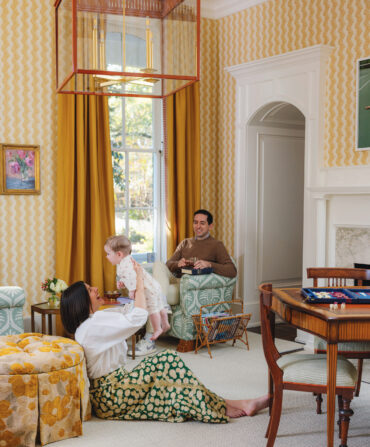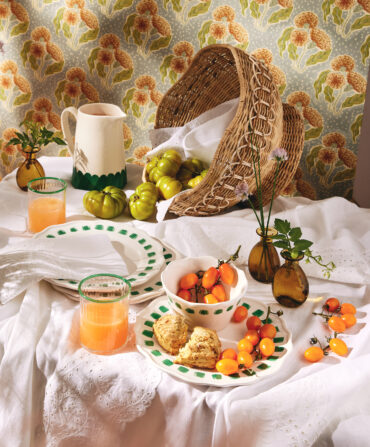In the Garden
Boxwood: An Antebellum Garden
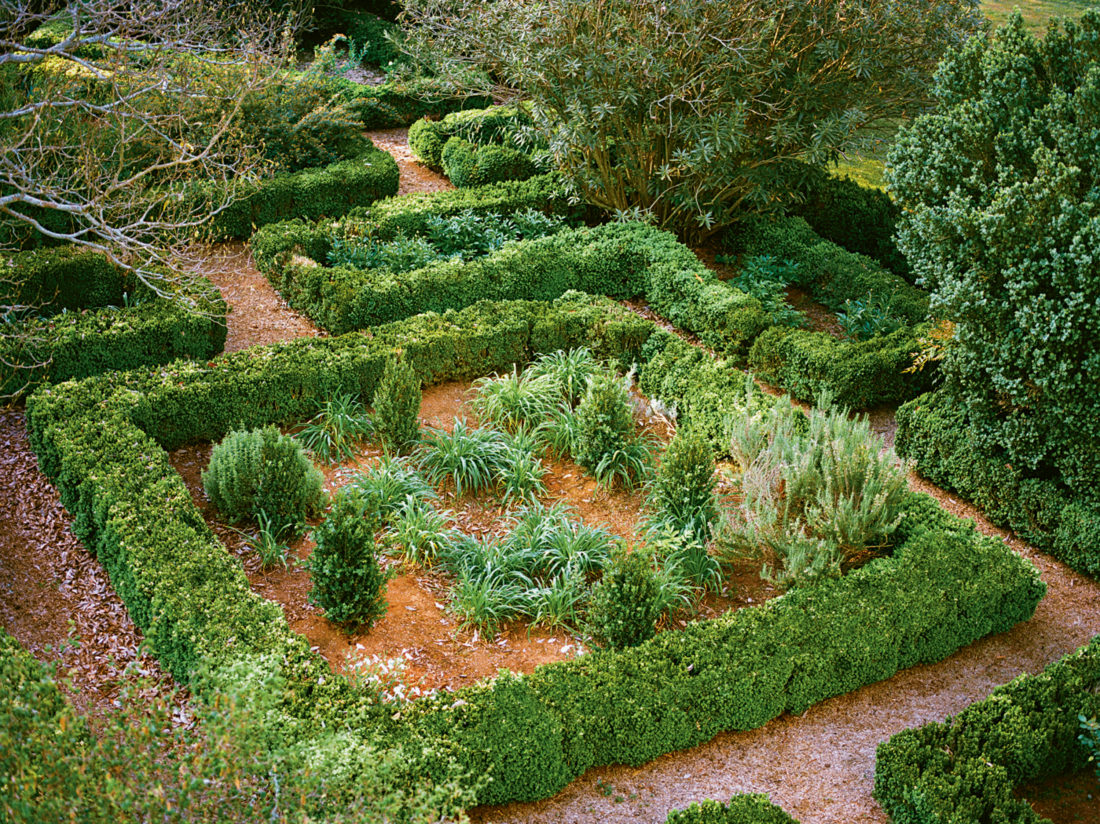
Photo: Andy Anderson
Just off Interstate 20, one hour east of Atlanta, lies a gem of an antebellum town named Madison, tucked away in history, a town thought by General William Tecumseh Sherman “too pretty to burn,” so the legend goes. Actually, the town didn’t get off scot-free. Union forces did burn the industrial and railroad facilities there. Madison lay directly on the Georgia Railroad path connecting Atlanta with Augusta and the Eastern theater, and was an appetizing target, but Sherman was somehow swayed by the plaintive appeals of Madison’s prominent resident Joshua Hill, a Union sympathizer who had recently lost his son Legare at Cassville, and who had met Sherman when he went to retrieve the body in Atlanta. And so the historic downtown was saved from destruction, including an exquisite house and garden known as Boxwood, also known as the Kolb-Pou-Newton House, and, with it, one small memento: In the ruby-colored glass surrounding the front door is the mark of a Union officer who simply couldn’t resist etching his name in the glass, where his signature remains today.
Madison was founded in 1809 and named in honor of our fourth president, James Madison, who negotiated a treaty with the nearby Creek Indians. The early settlers, many of whom had served during the Revolution, planned their town with a geometric regularity that reflected their Colonial background. During the cotton boom the town prospered, and circa 1850, at the height of Georgia’s antebellum wealth, a man named Wildes B. Kolb built Boxwood, a magnificent house with a double façade (one side Italianate, one side Greek revival) and twin parterre gardens enclosed by a white picket fence. The property was purchased in 1869 by Louis W. Pou, whose family occupied it until 1906, when it was bought by John Thomas Newton, whose descendants have faithfully cared for it ever since. Boxwood, which is listed in the Historic American Buildings Survey, is now maintained by Floyd and Jean Newton.
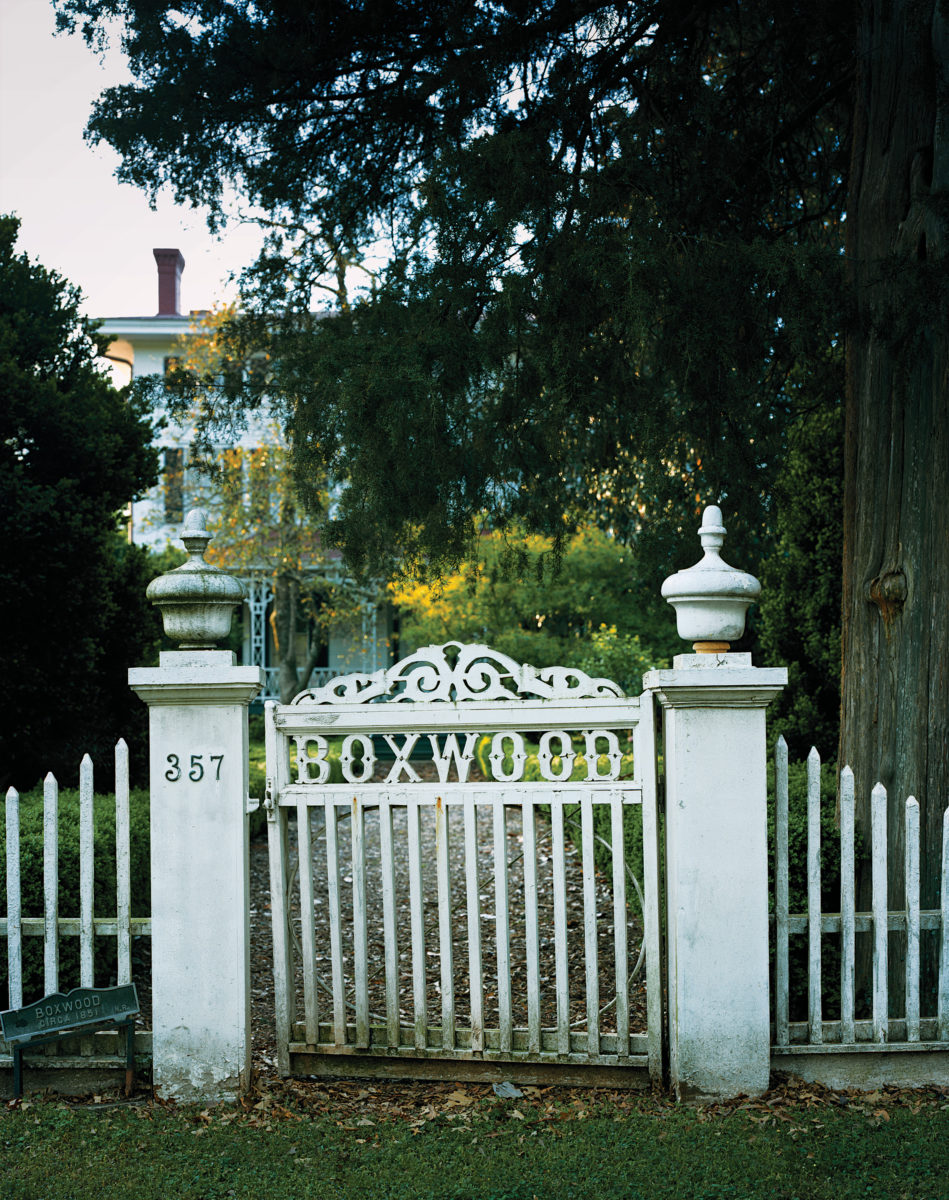
Photo: Andy Anderson
I arrived in Madison on a beautiful spring Sunday afternoon and made my way down its quiet, sun-dappled streets past stately white-columned homes in search of Boxwood. I was happy to have left the interstate behind. In the five minutes it took me to drive from I-20 to downtown Madison, I felt as if I were being catapulted back in time, away from the traffic and concrete and the pre-fab gas stations, and into some fairy world where time had slowed to a gorgeous halt. I found Academy Street, and immediately recognized the great expanse of clipped geometric boxwoods from the few pictures I had seen in books. A housekeeper ushered me inside through the great central hall and into a drawing room to wait for Mr. Newton, who was working in his study. The interior of the house was comfortable but stately, with 14-foot ceilings, period furniture, fine paintings, and towering French doors. Mr. Newton agreed to take me on a tour of his grounds, accompanied by his brother-in-law, Sonny Hunt.
It’s funny how Southern gentlemen refuse to call themselves gardeners, even when in reality they know everything there is to know about the subject. It must be a form of modesty, or perhaps a respectful nod to the women in their lives who were or are perhaps even more involved with the hands-on work in their gardens. Such a one was Mr. Newton’s Aunt Kittie, who was president of La Flora Garden Club in 1950, and whose generosity with her clippings mothered hundreds of boxwoods all over town. Or perhaps it is simply a defense of their masculinity, lest any man actually admit to liking flowers. In any case, as we strolled through the gardens it became eminently clear that these gentlemen knew much more than I did about native and heirloom plants. In fact, Mr. Hunt admitted that he has successfully rooted his own daphne (a favorite shrub of mine), and Mr. Newton has grafted and planted more than 230 camellias over at his property in Griffin, Georgia. Suffice it to say, I was humbled by their knowledge and experience.
In his grafting experiments with his camellias, Mr. Newton has produced a variety that he named “Miss Mary” after his mother.
Without Mr. Newton’s active interest in his garden, Boxwood would surely not be what it is today. We all know how unruly Mother Nature can be, and it takes no time at all for things to return to the wild. I gathered that Mr. Newton has hired help for general upkeep such as weeding and trimming, but I clearly perceived that he is the master of his own garden. Boxwoods themselves do not live forever, and can become uneven or bare, so to maintain the continuity of the original design and planting Mr. Newton keeps rooted cuttings on hand to replace individual boxwoods when necessary. Thus, the entire garden derives from the same stock of old English border box planted around 1854.
Many of the garden plants are older than Mr. Newton himself. There are two towering bay trees original to the garden. The antique rose bushes explode with blooms year after year, requiring no care at all besides the occasional trim. Any newer plants have been introduced by Mr. Newton very selectively, such as his dawn redwood tree, a prehistoric tree thought to be extinct until a pilot spotted a small grove in 1941. This redwood is now cultivated and protected in its natural habitat in the Sauraton Mountains of North Carolina, in the Crescent Ridge Dawn Redwoods Preserve. Mr. Newton’s is thriving.
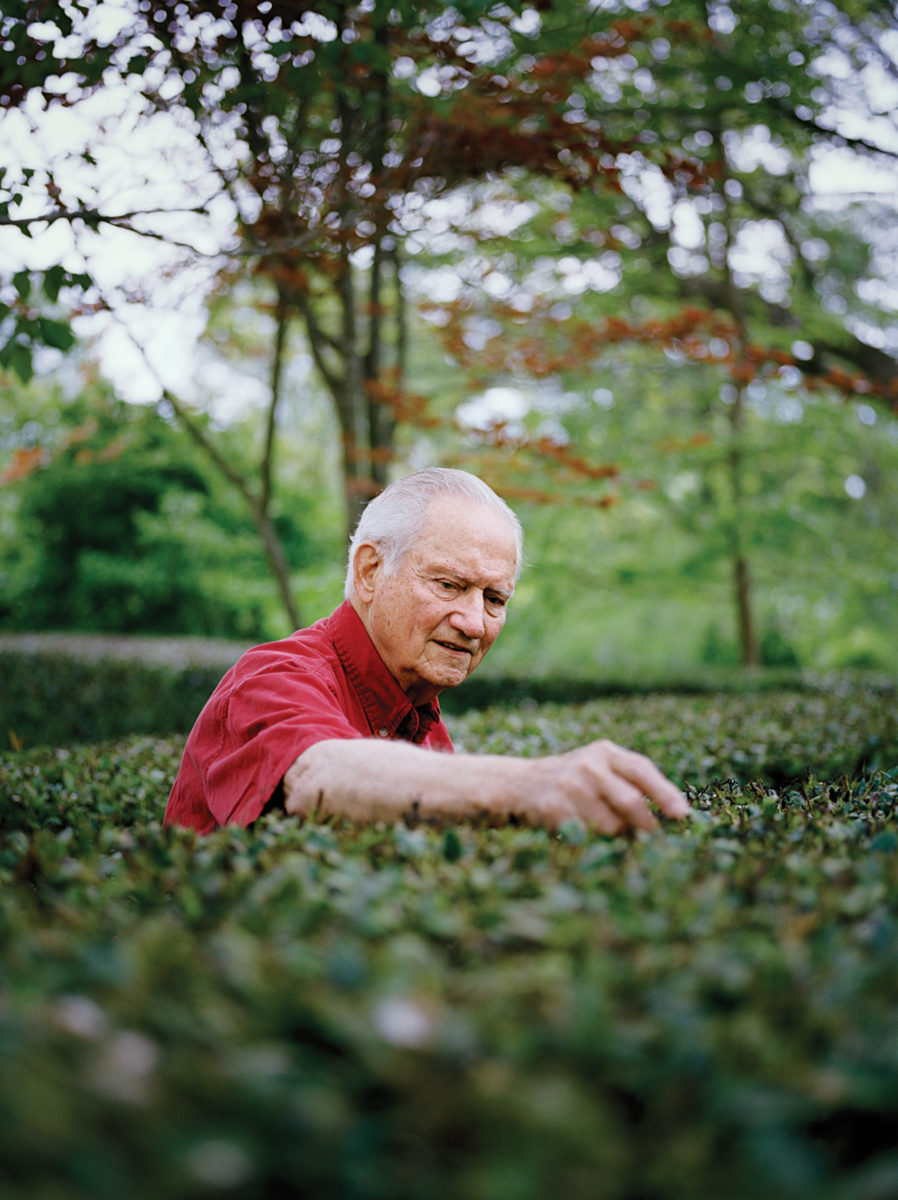
Photo: Andy Anderson
I was taken up to the second-floor balcony to observe the layout of the garden from above. Certain trees have grown to obscure somewhat the original design, but I could still make out the squares and pathways that I had seen in Thornton Marye’s 1933 drawing, which I carried with me in a book titled The Garden History of Georgia: 1733-1933, published on the occasion of Georgia’s two hundredth anniversary. Mr. Newton had the same book, and had taken this very drawing to his friend, a landscape designer in Griffin, to seek advice on how to make improvements such as erosion control without disturbing the integrity of the original design. Certain plants that had disappeared over time were then reintroduced, such as the set of vertical boxwoods planted in a circle within the square box borders.
Spring was just beginning to show itself on this warm, sunny day. Pink blossoms unfolded on a Japanese magnolia, and the cherry blossoms were on the verge. In a few weeks, the garden would come to life. Mr. Newton explained that Madison is a full degree cooler than any town merely thirty miles south of it. Long ago, the ocean used to come all the way up to the center of the state, leaving a stark line along which there are significant climactic differences, so Madison is slightly behind its southern neighbors — in gardening terms, on the northern edge of Zone 8.
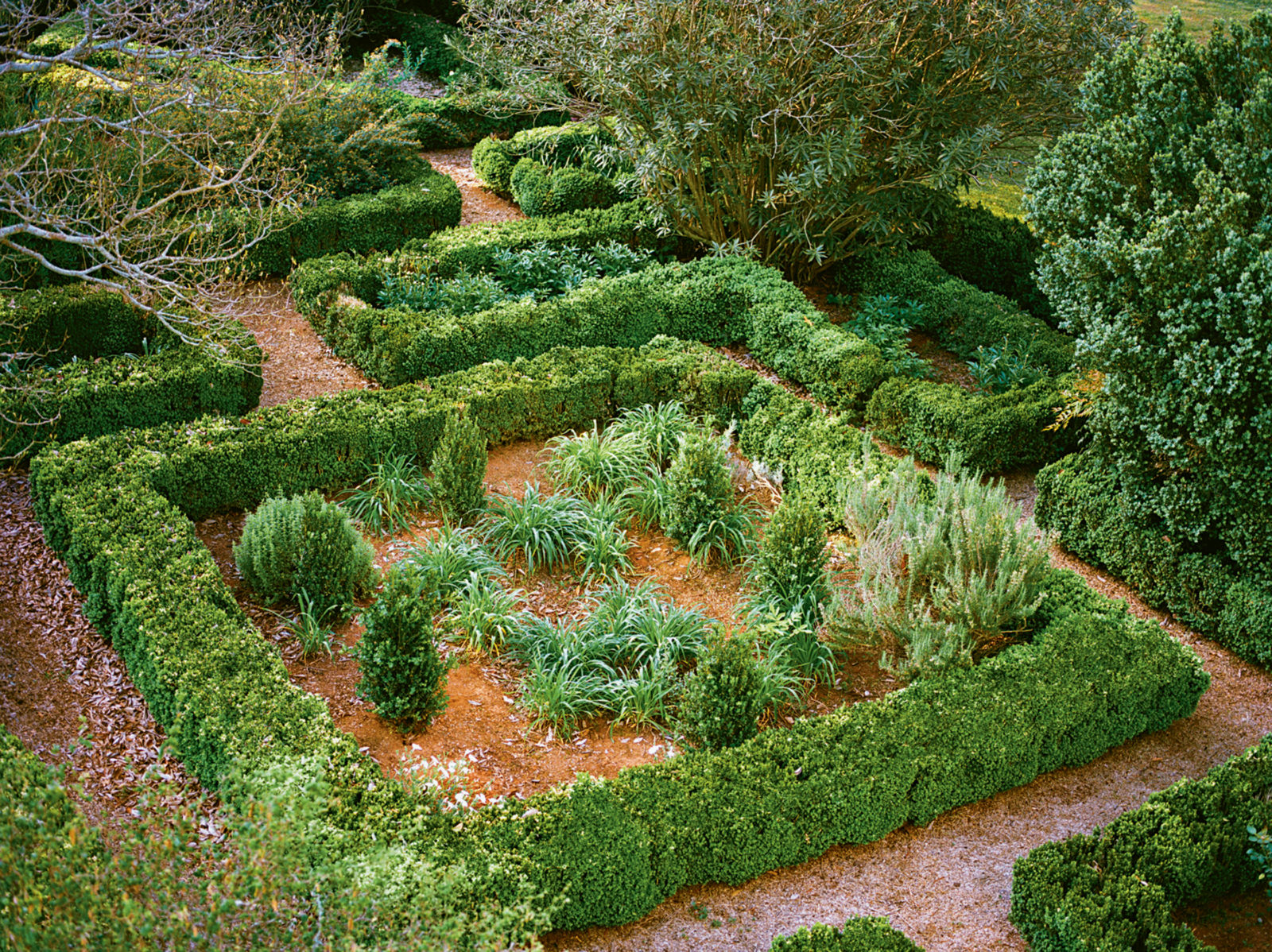
Photo: Andy Anderson
From the balcony we could see the side yard, which, according to the drawing, used to be a planted field. Mr. Newton chuckled recalling how, in his childhood, he and his friends would take pot-shots from the third-floor window at the pesky chickens that would stray into their cornfield from the reclusive neighbor’s yard. He couldn’t recall if he had actually hit one, but perhaps he was just saying that for my benefit. In recent years, the side yard was tastefully converted into an unpaved circular driveway, its center accented with a row of elegant cypress trees.
We descended into the gardens for a tour. The first mystery shrub turned out to be a Harry Lauder’s walking stick, or “twisted filbert,” whose branches contort in an unusual corkscrew pattern, a European cultivar introduced to the United States in the mid-1800s and named after the Scottish comedian Sir Harry Lauder, who performed using a crooked branch as a cane. In the beds I recognized the leaves of some “surprise lilies,” or “magic lilies,” so named because their blooms rocket out of the ground in mid-summer when you least expect them, after other lilies have finished performing. They are also known as “naked ladies” because their leaves die back before the flower stems spring forward, leaving their graceful slender stems embarrassingly exposed. Also of interest were tree peonies, a deciduous peony shrub whose wooden stalks do not die back in winter and whose massive yellow blooms are breathtaking.
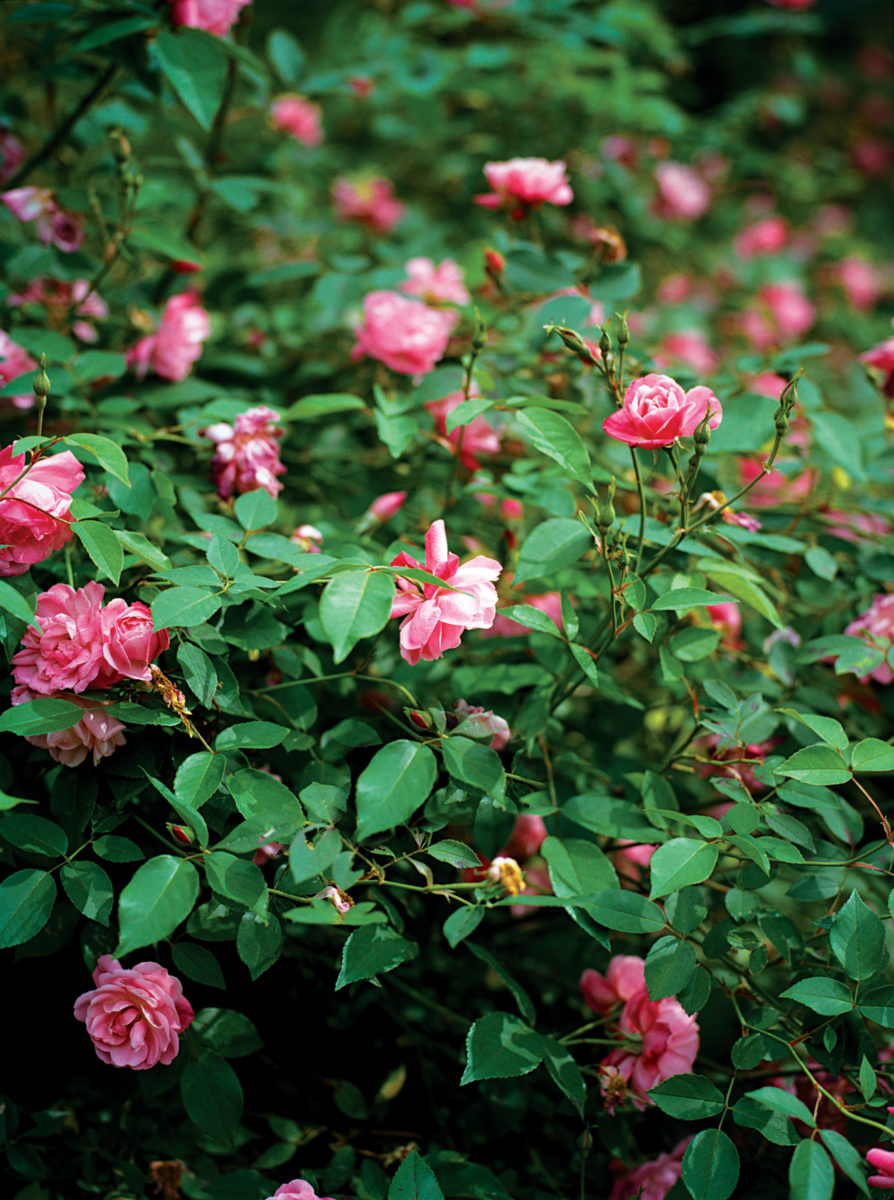
Photo: Andy Anderson
In his grafting experiments with his camellias, Mr. Newton has produced a variety that he named “Miss Mary” after his mother. The Miss Mary produces large blossoms of pink-tipped petals that fade to a white center. As the climate warms, the petals take on a deeper color. He handed me a flower to admire and seemed justifiably proud of his achievement.
We strolled past a very large crape myrtle into the northeastern side yard, where stand the old slave quarters and a smokehouse, both carefully renovated to preserve the original pine and bargeboard detailing from the 1850s. Although the wood was once whitewashed, it now has the faded patina that only weather and time can bring. A concrete floor had been poured in the smokehouse, but the overhead beams are original. The former slave quarters, a two-story house, have been nicely converted into a guest house. Across from this outbuilding sit the brick entrance to an old cistern covered in fig ivy, and behind it, enclosed by boxwoods, an equally old well. And at my feet lay an Indian corn mill found on the property. When I asked Mr. Newton which Indians were here, he joked, “I don’t know. I never did meet any of them.”
I asked Mr. Newton how on earth he keeps up with his garden, and he replied with a wink, “it keeps me from drinking and gambling… but don’t print that!”
Turning towards what used to be a horse pasture, we passed quickly by the swarming bees of an ancient holly tree, original to the earliest planting of the garden. This side yard is Mr. Newton’s free pass to plant what he wants, since the field was never a part of the boxwood garden design, but nonetheless he has been careful to stick with native and heirloom plants to keep with the period of the house. A rose garden is centered in the field, surrounded by lawn and edged with hydrangeas, white-flowering quince, pearl bush, flowering almond shrub, sweet bay shrub (for cooking), and native azaleas, so different from the more common ornamental hybrid from Southeast Asia. The field is lined on the northwest with ginkgos, and on the northeast with figs. I asked Mr. Newton if he manages to harvest the figs each year before the squirrels do, and he replied that he has a harder time reaching the figs before the neighbors do. As for the squirrels, the City of Madison has given him a license to shoot, more so for the protection of the historic house than for protection of the figs.
Along the periphery of the twin boxwood pattern on the Academy Road side of the house Mr. Newton was experimenting with variegated English boxwood, which did not appear to be thriving. I could only smile when he admitted that he may have mistakenly run over it with his lawnmower two or three times. Close by were nandina shrubs weighted down with their bright red berries, a shrub cursed by Mr. Newton for its invasive tendencies: Little nandina volunteers spring up amidst the geometric boxwoods, requiring Mr. Newton to cut them to the ground on a yearly basis.
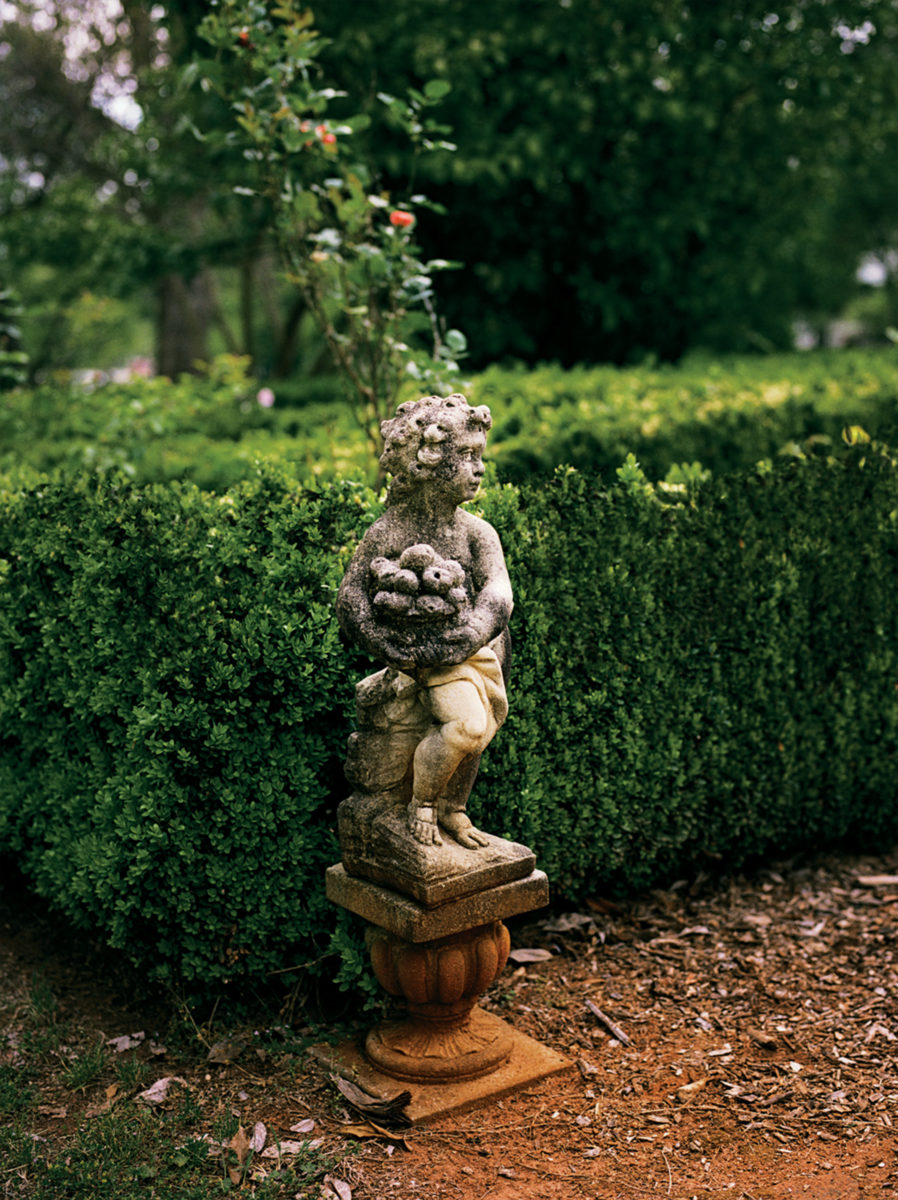
Photo: Andy Anderson
We arrived at one of his prize plants, the Franklinia alatamaha, discovered in 1765 along the Altamaha River in Georgia by the famous father-and-son explorers and botanists William and John Bartram. William later gathered seeds to propagate at their Philadelphia garden, and named the small tree after his close friend Benjamin Franklin. Unfortunately, he misspelled the river’s name, and it stuck. No longer found in the wild, the Franklinia alatamaha is still available at select native and rare plant nurseries.
The trees, flowers, and shrubs in this garden are too numerous to name, but let me mention a few. The smoke tree along the entry path is a flowering deciduous shrub that in summer produces inconspicuous wispy plume-like puffs. The Grancy Graybeard, bordering the side yard, has delicate fragrant blooms that cascade downward like the white beard of a wise old man. Also in the side yard is a Chinese Kousa dogwood, which sports white May-June flowers and purple and scarlet fall leaves. Mr. Newton’s heavenly scented American tea olive is thought by the well-known Southern gardener Jane Symmes to be the biggest such shrub she has ever seen. A banana shrub graces the front porch with the perfume of its fragrant creamy-yellow blossoms shaded with purple. Just across the path is a Carolina allspice, a deciduous shrub with a distinctive cinnamon-colored flower. As a child, Mr. Newton used to gather sweet shrub blossoms together in a handkerchief for their perfume. The star magnolia is a small, slow-growing magnolia with white, delicate petals. Scilla, or wood hyacinth, is an age-old flower that Mr. Newton dug up in Griffin and transported to Boxwood; the same goes for the wildflower Queen Anne’s lace. Also in the garden are purple Buddleia butterfly bush, forsythia, mock-orange shrub with its fragrant white flowers, lilac, old petunias, wiegela, hollyhocks, spiderwort, daylilies, rosemary, lavender and thyme, and on and on and on.
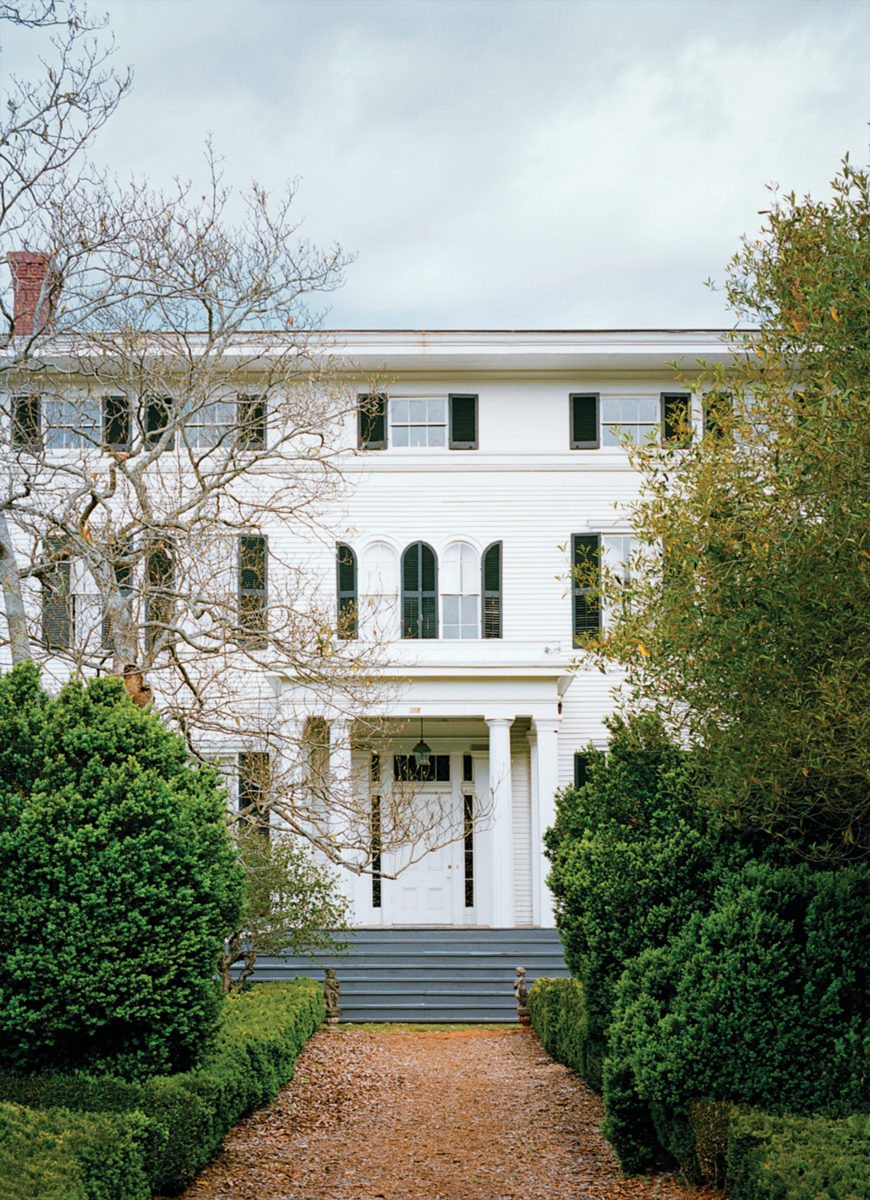
Photo: Andy Anderson
As for the squirrels, the city of Madison has given him license to shoot, more for the protection of the house than the figs.
I asked Mr. Newton how on earth he keeps up with his garden, and he replied with a wink, “It keeps me from drinking and gambling … but don’t print that!” Wise words. It wouldn’t hurt any of us to get our hands in the dirt every once in a while. Once, when Mr. Newton was trimming back his spirea shrub, he discovered a sizable collection of empty vodka bottles hidden behind it. He quickly deduced that an old visitor of Aunt Kittie’s must have been doing much more than sitting on the front porch admiring the gardens.
I left Boxwood that day full of stories, garden scents, and images, with a crushed bay leaf in my hand and a giant Miss Mary camellia blossom for the dashboard, and headed back out to the concrete sterility of the interstate.
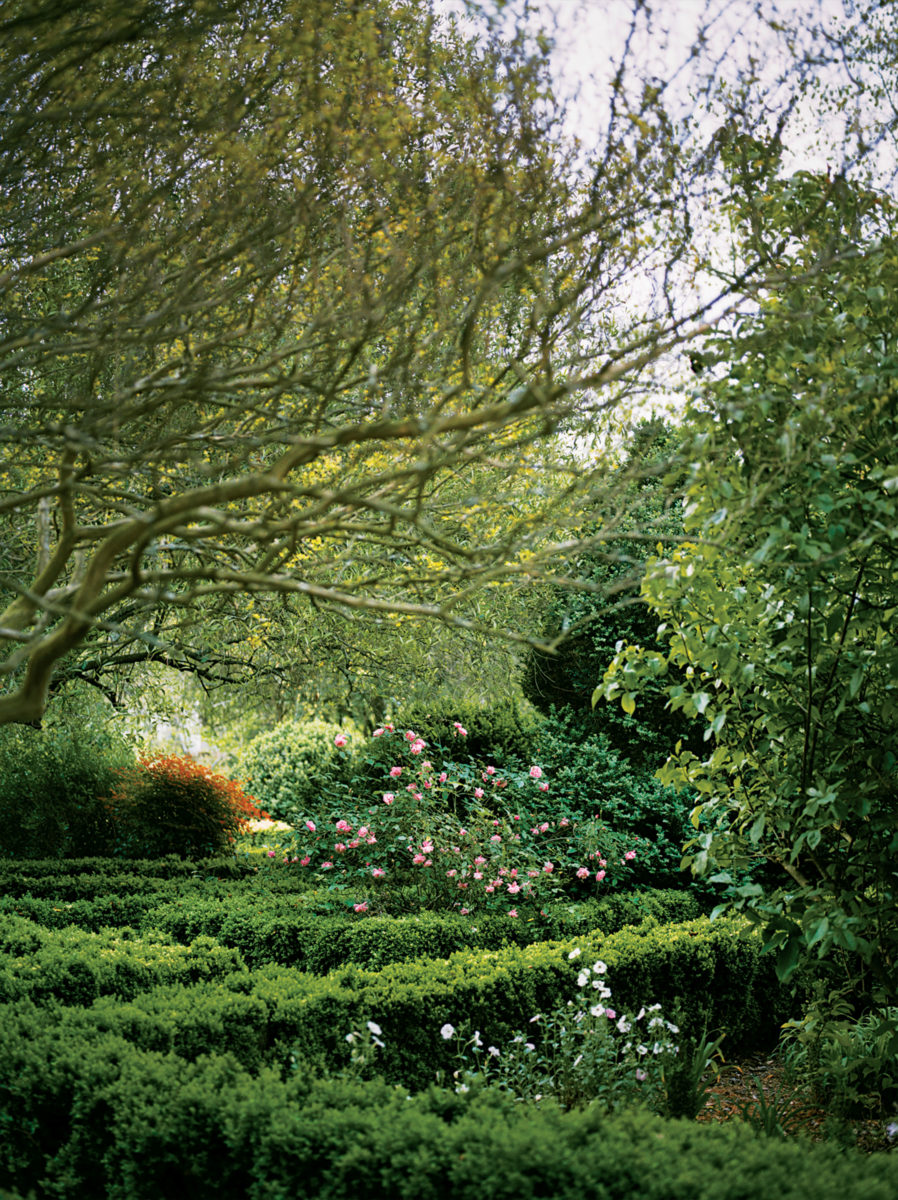
Photo: Andy Anderson


